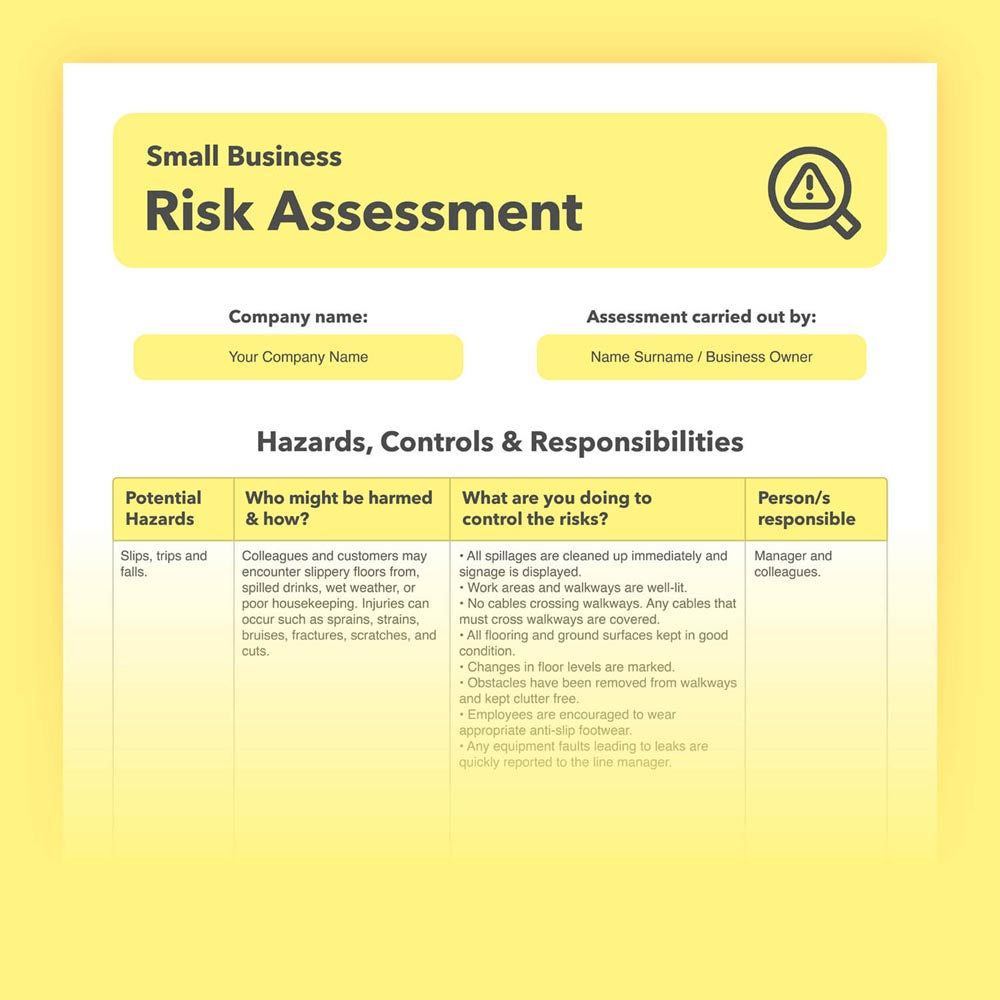
What is a Risk Assessment?
A risk assessment is the process of identifying hazards that currently exist or may appear in the workplace, how they may cause harm to employees (visitors etc) and the steps that need to be taken minimise harm.
Risks need to be considered in all aspects of the working environment, here are some examples:
Hazards:
Lifting heaving supplies (manual handling), a rainy day and the entrance floor is wet (slips, trips and falls), storage of a flammable liquid (fire safety), working alone (stress and violence), overloaded extension lead (electrical safety).
Tasks:
Cleaning with chemical substances with the public around, maintenance contractor work or dealing with the public.
Organisational factors:
Safe systems of work, policies, working hours, consultation with employees and shift patterns.
Who needs to complete a risk assessment?
Every employer must conduct a risk assessment on the work their employees do. If the company employees more than five employees then the results need to be recorded.
Whoever completes the risk assessment should have the knowledge and experience to recognise hazards and put sensible controls in place. You could appoint yourself as usually managing health and safety isn’t complicated. You know your workplace best and the risks associated with it.
Tip: I have less than five employees, am I exempt?
In short, no. You still need to risk assess your work, it is a legal requirement, however, you are not legally required to record it, but it would be best practice to do so.
Why are risk assessments important?
You should carry out risk assessment to keep you and your team safe, and to make sure everyone finishes the job in one piece. Don’t just do your risk assessment to comply with the law, complete them to prevent harm.Eight reasons why risk assessment is important:
- Spots hazards
- Look at the potential harm.
- Identify who might be harmed.
- Protect people at risk
- Review existing controls
- Plan the work safely
- Make improvements
- Comply with the law

Fact: Accident rates are lower where employees genuinely feel they have a say in health & safety, compared to workplaces where employees don’t get involved (source: unison.org.uk)
How do I complete a risk assessment?
The HSE outlines 5 steps that should be followed in the risk assessment process.
- Identify the hazard
- Decide who might be harmed and how
- Evaluate the risks and decide on control
- Record any significant findings
- Review and update the risk assessment (if necessary)
Below are some examples on how to control hazards mentioned previously:
- Hazards: lifting heaving supplies (manual handling) - can a trolley be provided or can it be broken down into smaller loads?
- A rainy day and the entrance floor is wet (slips, trips and falls) - is it possible to put a mat down, dry mop the floor, and add notices to warn of the hazard?
- Storage of a flammable liquid (fire safety) - is there an alternative liquid available that isn’t flammable?
Summary
Don’t forget, one of the main reasons risk assessments are important is to make improvements.
Needing a risk assessment might seem overwhelming at first, but remember, if you have low-risk activities in your business, with only a few hazards that are unlikely to cause any serious harm, your risk assessment does not need to be long or complex. Your controls are probably going to be cheap and easy to implement.
Focus more of your efforts on higher risk activities as a suitable and sufficient risk assessment for these activities is likely to be more in-depth, with tighter controls.

